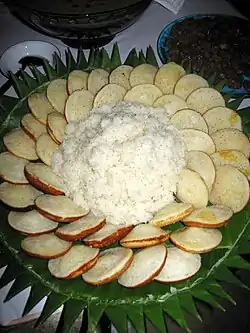Serabi
Serabi, also called surabi, srabi, also known in Thailand as khanom khrok, is an Indonesian pancake that is made from rice flour with coconut milk or shredded coconut as an emulsifier. Most of traditional serabi tastes sweet, as the pancake is usually eaten with kinca or thick golden-brownish-colored coconut sugar syrup. However, another savoury version also existed that uses oncom toppings. Different provinces in various Asian countries have their own serabi recipes corresponding to local tastes.[1][2]
 | |
| Alternative names | Soerabi |
|---|---|
| Type | Pancake |
| Place of origin | Indonesia |
| Region or state | Southeast Asia |
| Main ingredients | Rice flour, coconut milk or shredded coconut |
| Similar dishes | Banh khot, mont lin maya, takoyaki, khanom khrok |
Serabi is a traditional cake that seems to originate from Java, Indonesia.[3]
Variants
01.jpg.webp)
The most basic traditional serabi only employs batter made from the mixture of rice flour, coconut milk, and coconut sugar, cooked upon small earthenware frying pan on charcoal fire. Sometimes pandan leaf juice might be added into this batter mixture to add aroma and a greenish color. During the cooking process, sometimes toppings are added to the batter.
Today, a large variants of serabi toppings are used, from simple sprinkle of sugar, grated coconut flesh, sprinkles of coarsely ground peanuts, slices of banana or jackfruit, chocolate sprinkles, black glutinous rice, and oncom, to a new recipe using grated cheddar cheese, corned beef, shredded chicken, slices of fresh strawberry or sausage, or even strawberry ice cream. The sauce (or more precisely syrup) to accompany serabi also varies, from traditional sweet kinca (golden colored coconut sugar syrup) sometimes creamed with coconut milk, to modern recipe using chocolate, strawberry, or durian syrup, and mayonnaise or cream cheese for savoury western twist.
Both the cities of Bandung and Solo are famous for their versions of serabi. Bandung surabi is drier and firmer with a pancake-like consistency, and today is well known for the rich variant of toppings, most are recently developed fusion recipes. The serabi from Solo, however, is more traditional with a little bit half-cooked with thin, crispy crust and watery center with rich coconut milk taste. A famous serabi variant from Solo is called serabi notosuman.
References
- Sri Owen, Indonesian Regional Food and Cookery Page 200
- Justine Vaisutis, Lonely Planet Publications (Firm) Indonesia Page 82
- Boga, Yasa; Hadibroto, Cherry; Kartohadiprodjo, Nies; Tobing, Hayatinufus; Adimidjaja, Linda (2008). Kue-kue Indonesia, (1 ed.). Jakarta: Gramedia Pustaka Utama. p. 53. ISBN 9792238603.
External links
| Wikimedia Commons has media related to Serabi. |
